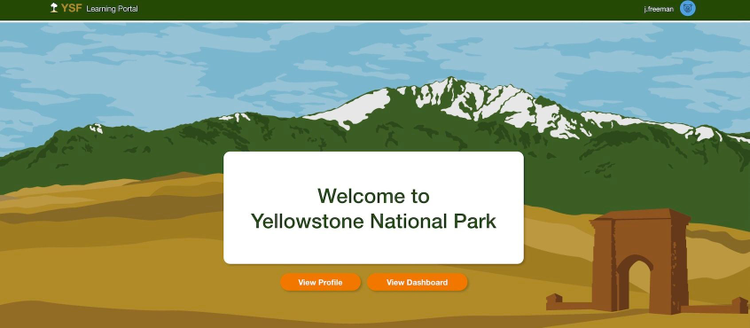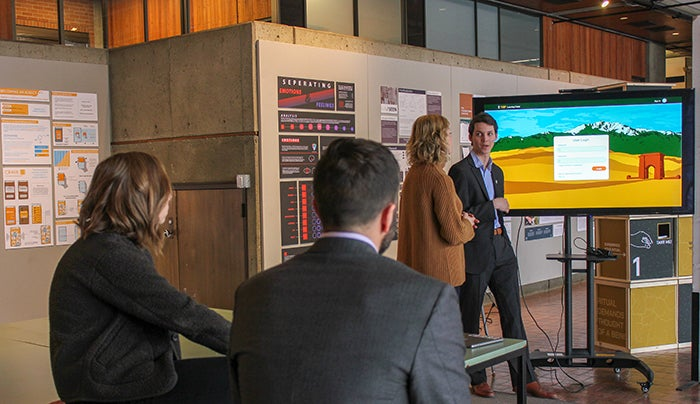How the University of Utah and Yellowstone National Park Are Fostering the Next Generation of Design Leaders

The University of Utah’s Multi-Disciplinary Design program has students prototype digital experiences that solve real-world problems faced by Yellowstone National Park, like this distance learning product by Steven Calhoun.
Inspiration isn’t hard to find in Salt Lake City, Utah; one look out the windows of the University of Utah’s campus, and you’re treated to sheer visual splendor. Tall mountains, a clean cityscape, and a whole world of colorful nature within easy reach. While Salt Lake City may seem far from the world’s ‘digital design hotspots’ in the Bay Area and beyond, its location has led to something truly exciting at its university. The University of Utah’s Multi-Disciplinary Design Program is teaching the next generation of product designers to not only take inspiration from the extraordinary nature around them and turn that into beautiful digital products, but to use those digital product design skills to protect that beautiful nature itself.
“Our idea was that if we want students to have a positive impact, to take design thinking and use it to conserve and save things in the world then we take them out to the field and to the wilderness,” said Elpitha Tsoutsounakis, adjunct professor at the University of Utah, who runs the design program’s Field Studio.
“For that reason, I think that it could have only happened here in Utah. The Field Studio is dedicated to taking the students outside, taking them camping, forcing them to think about our relationship to nature and to wilderness. In order to become good and ethical product designers, the students need to first think about ‘no product.’ They’re not looking for problems to solve, but they’re looking at an opportunity to have impact.”
Watch the University of Utah’s Multi-Disciplinary Design program in action. Video credit: Robbie Campbell.
This school year, the undergraduate program partnered with Yellowstone National Park, and the Field Studio class was tasked with finding ways digital products and technology could serve some of the park’s key objectives. These ranged from improving distance education, wayfinding, preservation, and beyond. Students used Adobe XD to prototype their experiences, or even just to help concept problem solving solutions for Yellowstone, and the work sounded so exceptional, Adobe’s strategic development manager Tara Knight just had to see for herself.
“When I first heard about the program, it was easy to see there was something special happening in Utah. I invited Cord Bowen, who leads the program, and Kris Paries, an Adobe designer who teaches there, to speak at an XD for Educators event I held at Adobe MAX. The more I heard about the dedication to teaching and honoring the process that leads to well-designed, thoughtful solutions, and saw the knockout work from students to back that up, I had to meet the talent face to face.”

In the University of Utah’s architecture building, home of its design school, students show offer their prototypes to Adobe’s Tara Knight.
In this collection, which reflects our visit to the university and time spent with the design students and faculty, we’ll explore two exceptional projects: one that takes a fresh look at distance education and one that uses animation to boost engagement with fundraising efforts, hear about the ways learning design process has helped the design students evolve, personally and professionally, and how this whole experience has launched the design students on an exciting journey to make the world a better place through design. Check out a brief preview of the projects and the students behind them below, and continue reading the collection to see the incredible strides in design education being made at the University of Utah.
Two incredible projects, two different design processes
While there were nearly 20 projects created for Yellowstone in this year’s Field Studio course, we focused on two projects that took fresh approaches to conventional design problems faced by the park. The first one, created by Steven Calhoun, is called the Yellowstone Forever Learning Portal. In it, Steven created an entirely new approach to distance education for children. He wanted to create an educational tool that would be engaging, user-friendly, and fun for students.
He built out interactive user flows in Adobe XD, for both student and teacher, that capture a gamified and highly-visual approach to learning materials. Check out the video below to see Steven’s prototype, and read how his approach to research and design process helped him share the majesty of Yellowstone with those who can’t experience it in real life.
A preview of Steven Calhoun’s project, the Yellowstone Forever Learning Portal.
Students Erica Fasoli and Zachary Kay took a different approach to using Adobe XD. They treated it as a tool to conceptualize their solution to a key problem: how to make fundraising more effective for the park. After considerable research on the ground in Yellowstone, they set out to find digital means to communicate the concept of wild (and the need to protect it), using XD, in a way that would inspire people to donate to the park, even if they couldn’t easily access the park itself.
Using XD’s Auto-Animate feature, they built interactive, fully-animated designs that teach people how nature affects their daily life. They also used the digital presence to highlight a physical design, a bracelet, that people would get if they donated. Check out their animated prototype below, and read how Erica and Zachary used rapid iteration to find the ideal user flow to move the dial on fundraising for Yellowstone.
A preview of Erica Fasoli and Zachary Kay’s project, The Wild Spectrum.
Evolving personally and professionally along with their design process
While the students were able to learn crucial UX/UI design skills through the Field Studio, such as research, design problem solving, and wireframing, the process of learning and applying design process ‘for good’ has had major effects on the students themselves, both personally and professionally. Steven, Erica, and Zachary have all found career opportunities that transition into full-time employment after graduation, but they’ve also found purpose in their work.
All three say they plan to use design to make the world a better place, whether at work or in their side projects. Rather than being ‘their dreams’ from the start, these realizations mostly came after being exposed to design thinking. Steven, Erica, and Zachary, like many of their classmates, didn’t realize how design foundations and digital design skills could be applied to problem solving. For them, learning design process has changed their view of the world; read how the Yellowstone Field Studio helped the students learn about themselves and kind of designer they want to be life.
If you missed any of our collection or articles, Doing Good with Design Education in partnership with the University of Utah, check out the others below.
- PART 2: Using Design to Introduce Yellowstone to the World Through Distance Learning
- PART 3: Using Design to Redefine Wild and Take a Fresh Approach to Fundraising
- PART 4: How University of Utah Students Evolve Along with their Design Process
- PART 5: Unlocking Careers and the Potential to Impact Yellowstone for Years to Come
Adobe Creative Cloud can empower students to think creatively and turn their classroom ideas into college and career opportunities. To learn more, visit the Creative Cloud for Education homepage.